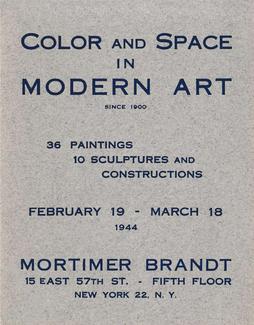
Color and Space in Modern Art Group Show
Dates : Samedi 19 février 1944 - Samedi 18 mars 1944
Adresse : Mortimer Brandt, 15 East 57th Street, 10022 New York
Mortimer Brandt
15 East 57th Street
Fifth floor
New York, NY 10022
États-Unis
Description, horaires...
For many years, our gallery has been associated with the Old Masters and will continue to maintain its activity in that field... But lately, we have felt the great need for a closer approach to these Modern days that are inscribing themselves so indelibly on our lives and in the pages of history.
Last season we inaugurated a new policy of exhibiting our own American Art exhibited the work of several promising American Artists... The time is not far away when the galleries throughout the world will justly accord representation to our own artists as we do theirs. We have great faith in the future of American Art... Our gallery will continue to show the work of talented American artists, but as art is international and should always remain so, we will also show the work of any worthy artist of any other country.
We feel that surveys as comprehensive as is possible under present conditions for us to show, of the tendencies of international art (since 1900) will be illuminating and interesting. In presenting this the first of such series of exhibitions, we dedicate it to those artists who have particularly emphasized the importance of... "COLOR AND SPACE".
My appreciation and thanks to the generous support of the lenders to the exhibition ; to Mr Robert Lebel for his help in our endeavor to assemble, for the first time, the work of Duchamp Villon and his two brothers ; Jacques Villon and Marcel Duchamp in a single exhibition room.
Mortimer Brandt
-----
SPACE PLUS COLOR
Some works of art take off, others stick to the ground. The moderns, with a new conception of space and color, have increased the climbing force and aerial quality of painting and also, curiously enough, of sculpture. As this exhibition aims to demonstrate, the conspicuous characteristic of this new art is buyancy. It produces on the spectator the physical effect of a deep breath of oxygen.
Nineteenth century works are crowed. Delacroix, the Impressionists and Cezanne have an instinctive fear of emptiness. In their paintings each object or figure is closely bound to the other. Seurat alone felt the necessity of relationships in space rather than by direct contact, and twenty years later, Chirico rediscovered the power of suspense. Today, in the plastic synthesis of movement and intervals which some of our contemporaries have achieved, distance and solitude play a poetic part.
At the same time, vibrant colors which the Fauves were the first to liberate form form, have gradually conquerd the abstract world in spite of its inital austerity. In Surrealism, high-keyed tones become and expressive echo of space ; and when they flare from regions beyond memory across the field of vision, they speak the airy, precise and humorous language of remoteness.
Robert Lebel
-----
THE THREE BROTHERS
It is peculiarly fitting that a group of work by Villon, Duchamp-Villon, and Duchamp shoul figure in the exhibition of a forward-looking gallery for, before the last war, the three brothers offered a rallying point for the artists in Paris who had arrived at a sense of new values in their own profession and in the whole movement of the time.
Those values continue to bring forth material results, as we see in the later painting of Jacques Villon. The war of 1914 cost us the life of Duchamp-Villon, and ended the splendid things that his vision of a collective art had already embodied in a building where all the men who gathered at his studio were represented by personal work of one kinf or another. Rather than see such a thing commercialize, the third brother, Marcel Duchamp, has withdrawn from physical production though not from participation in every effort that seems to him genuine.
Over all such effort hovers the spirit of the man who, in "Les Phares", has told, and immortally - pf the "light-houses" created by the great artists. Therefore the bust of Baudelaire on the present exhibition os not merely one more work by Duchamp-Villon. It is a symbol.
Walter Pach
-----
An exhibition with paintings by Henri Matisse (Stille Life Recumbent Nude, Mont-Alban), Raoul Dufy (Port du Havre, La Plage, Les Régates), André Derain (Repos, L'Estaque), Pablo Picasso (L'Atelier), Georges Braque (La Rivière), Juan Gris (Violon et Guitare), Wassily Kandinsky (Composition, Composition 239 with white oval), John Marin (Cliffs and sea), Marsden Hartley (Migration), Giorgio de Chirico (The Double Dream of spring, The War, Cassandra study n°5, The Regret, The Red House), Jacques Villon (Le Paradis, La Coquille, Intérieur), Marcel Duchamp (Les Joueurs d'échec, Le Passage de la vierge à la mariée, Boîte-en-valise), Max Ernst (La Planète affolée), Joan Miro (Pastorale, Portrait), Yves Tanguy (La Cloche perdue, Arriere pensée, Gouache), Esteban Frances (Arrangez-vous), Matta (In France, Comic Strip, To sleep in the rocks).
An exhibition with sculptures and constructions by Raymond Duchamp-Villon (Baudelaire, Les Amants, Le Chat, Le Cheval), Alexander Calder (Cage within a cage, Morrning star, The Red Wand), Isabelle Waldberg (La Prise de la Bastille, L'Antenne Totémique, Mask).